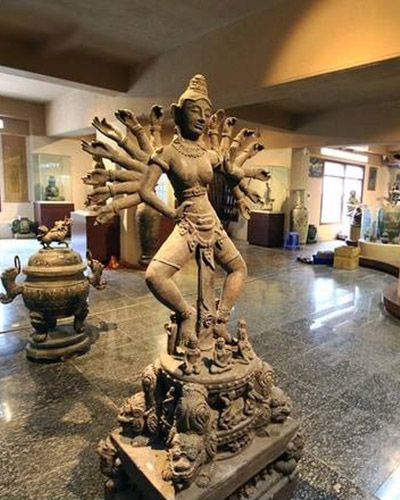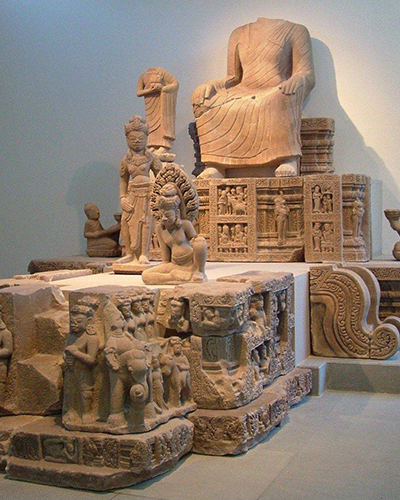Museum of Cultures of Vietnam's Ethnic Groups
GENERAL INTRODUCTION
The Museum of the Cultures of Vietnam’s Ethnic Groups is in the center of Thái Nguyên City, about 80 km
north of Hà Nội on National Highway 3. The Museum was built in 1960. At first it was named Việt Bắc Museum,
with its functions and tasks of scientific research and educating the traditions of culture and
revolutionary struggle history of ethnic groups in Việt Bắc.
.jpg)
.jpg)
In 1976, the Việt Bắc autonomous area was dissolved and the Việt Bắc Museum was handed over to Ministry of
Culture and Information. Since then, the Museum has changed its activities from an integrated museum to the
one specialized in ethnic cultures. At decision No. 508/QĐVH dated March 31, 1990 signed by Minister of
Culture, it was renamed the Museum of the Cultures of Vietnam’s Ethnic Groups and became one of the seven
national museums of Việt Nam.
The Museum of the Cultures of Vietnam’s Ethnic Groups is a big cultural center with its functions and tasks
of doing research, collection, inventory, conservation, exhibition, popularization and bringing into play
the heritage of traditional cultures of the Vietnamese ethnic groups in the entire country.
.jpg)
With the concern from the Party and State, specifically from Ministry of Culture, Sports and Tourism, the
Museum of the Cultures of Vietnam’s Ethnic Groups has developed day by day. During the past 50 years, the
Museum has conducted hundreds of researches and collections all over the country, acquiring nearly 30,000
valuable items. These were important for the Museum to prepare the indoor and outdoor exhibitions to serve
the domestic and international people.
Museum of the Cultures of Vietnam’s Ethnic Groups is well-known for its architecture which won the Hồ Chí
Minh Prize, situated on an area of 40,000m2 by the poetic Cầu River and at the centre of Thái Nguyên City.
The exhibition system of Museum of the Cultures of Vietnam’s Ethnic Groups was built on the basis of ethnic
language families in combination with regional cultures, introducing the cultural characters of 54 ethnic
groups associated with ecological landscapes of every settlement area, including 5 showrooms.
.jpg)
Showroom No. 1: Exhibits and introduces cultures of ethnic groups of Việt – Mường language family (Kinh,
Mường, Thổ, Chứt). The people mainly live on wet rice cultivation and fishing. In spiritual life, they
worship their ancestors. Their traditional handicrafts develop at high level.
Showroom No. 2: Exhibits and introduces cultures of ethnic groups of Tày – Thái language family (Tày, Thái,
Nùng, Giáy, Lào, Lự, Sán Chay, Bố Y). The people mainly live in stilted houses, cultivate rice fields on
valleys and along rivers and streams which are irrigated by canals, bamboo troughs and water wheels.
Handicrafts such as forging and weaving are fairly developed with beautiful and sophisticated products. They
have rich spiritual life including many unique Xoè dances and Then songs.
.jpg)
Showroom No. 3: Exhibits and introduces cultures of ethnic groups of three H’mông – Dzao language families:
(H’mông, Dzao, Pà Thẻn), Ka Đai (La Chí, La Ha, Cờ Lao, Pu Péo) and Tạng Miến (Lô Lô, Phù Lá, Hà Nhì, La Hủ,
Cống, Si La). The people are good in cultivation on burnt over land and terrace fields. Periodic market is
an activity which clearly shows the cultural characters of mountainous area including gastronomy, attire,
embroidery, printing patterns on fabric, performing music and khèn dancing etc.
Showroom No. 4: Exhibits and introduces cultures of 21 ethnic groups of Môn – Khmer language family (Ba Na,
Brâu, Bru – Vân Kiều, Chơ Ro, Co, Cơ Ho, Cơ Tu, Gié Triêng, H’rê, Kháng, Khmer, Khơ Mú, Mảng, Xinh Mun,
Mnông, Ơ Đu, Mạ, Rơ Măm, Tà Ôi, Xơ Đăng, Xtiêng). The people live scatteringly in the North – East, Central
– Central Highlands and South VietNam. They live mainly on cultivating burnt-over land by making holes for
the seeds with a digging stick. Architectures of communal house and long house on the Central Highlands and
pagoda of Khmer people; weaving handicraft and community cultural festival are unique cultural features of
the Môn – Khmer people.
.jpg)
Showroom No. 5: Exhibits and introduces cultures of ethnic groups of the Austronesian language family (Chăm,
Gia Rai, Ê Đê, Raglai, Chu Ru) and Han language (Hoa, Ngái, Sán Dìu). Ethnic groups of the Austronesian
language family inhabit mainly on the red-soil Central Highlands and coastal stretches of land in Central
VietNam; the Austronesian culture has the matriarchal characteristics. Ethnic groups of Han language family
inhabit in the North, Central and South VietNam; Han culture has the patriarchy characteristics.
With more than 4,500 original documents, artifacts, films, pictures and 735 supplementing scientific
documents, the museum exhibition system was built in an advanced and modern way. Electronic information
technology equipment and audio softwares help revive the settlement landscapes and cultural life of 54
ethnic groups, attracting the visitors.
.jpg)
Apart from the fixed exhibition, every year, the museum conducts dozens of mobile exhibitions all over the
country, from remote areas to borders and islands, meeting the people’s demand to enjoy culture.
Together with activities of the museum, its officials often participating in topics of ministry and
institute levels on ethnic cultures. In addition, the lectures, talks and exchange of experience are also
carried out by its staff to introduce and popularize the values of ethnic cultures.
At present, the museum’s outdoor exhibition system has been completed with spaces of 6 cultural areas:
Mountainous area in the North, Valley, Middle land – North VietNam, Central VietNam – Coastal area, Trường
Sơn – Central Highlands and South Vietnam Plain. Every cultural area has a space of organizing festivals
with landscape structure of its own characters and a specific house as a focal point to introduce the
cultural values of the Vietnamese ethnic groups to visitors.
.jpg)
.jpg)
.jpg)
.jpg)
.jpg)
.jpg)
.jpg)
.jpg)
.jpg)





